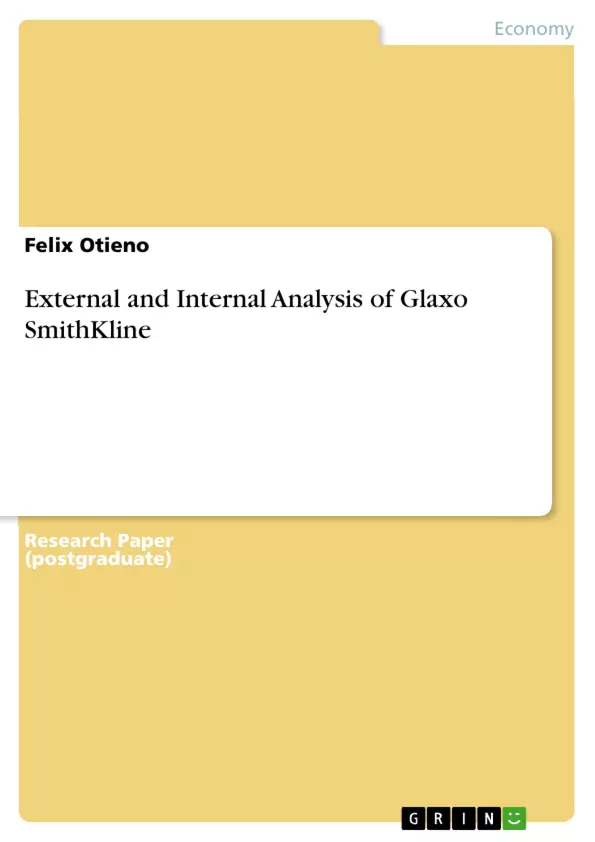The common goal of any organization is to achieve its objectives which revolve around profit, survival and prosperity. Robert M. Grant (1991:22) identifies two routes to achieve their objective which includes the location of an industry favorable to earn a rate of return above the competitive level and attain a position of advantage over its competitors within the industry, allowing the company to earn return more than the average return of the industry. Duane Ireland et al (2005) mentioned that internal and external analysis is important for the managers in order to develop and the implement the best strategy by evaluating the capabilities and resources of the firms and customer preferences in the market. Glaxo SmithKline (GSK) with a long history dating back to 18th century produce 9 billion Tums tablet, 6 billion Panadol tablets and 600 million tubes every year with more than 200 million customers worldwide and spends more than £300,000 every hour into research and development for innovation in medicine. The company has been able to compete in the industry with strong customer base all over the world, just because of its business strategy which is aimed at increasing growth, reduce risk and improve GSK’s long term financial performance which include growing a diversified global business, deliver more products of value and simplify GSK’s operating model. The present study aims at identifying the key drivers for change, critical success factors, key business strategies over the past five years using Porters generic strategies and resource and capabilities of GlaxoSmithKline over the past ten years so as to analyze the business strategies.
Inhaltsverzeichnis (Table of Contents)
- Introduction
- Core Elements of the Glaxo Smith Kline
- Market Share
- Level and intensity of market competition
Zielsetzung und Themenschwerpunkte (Objectives and Key Themes)
This study aims to analyze the business strategies of GlaxoSmithKline (GSK), a global healthcare company, over the past ten years. The study uses Porter's generic strategies and an analysis of GSK's resources and capabilities to identify key drivers for change, critical success factors, and key business strategies implemented by the company.
- Internal and external analysis of GSK's business strategies
- Key drivers for change and critical success factors
- Application of Porter's generic strategies to GSK's operations
- Evaluation of GSK's resources and capabilities
- Assessment of the company's competitive landscape
Zusammenfassung der Kapitel (Chapter Summaries)
- Introduction: This chapter introduces the concept of organizational objectives and the importance of internal and external analysis for strategic decision-making. It provides an overview of GSK's history, operations, and business strategy.
- Core Elements of the Glaxo Smith Kline: This chapter provides a detailed overview of GSK's business operations, including its major product lines, segments, and geographical presence. It discusses the company's focus on treating diseases like malaria, HIV/AIDS, and tuberculosis.
- Market Share: This chapter examines GSK's market share in the global pharmaceutical industry. It highlights GSK's position as one of the largest pharmaceutical companies worldwide and discusses the company's efforts to maintain its market share in a highly competitive environment.
- Level and intensity of market competition: This chapter delves into the competitive dynamics of the pharmaceutical industry. It analyzes GSK's competitive advantages and its strategic response to competition from major players like Novartis, Pfizer, and Sanofi Aventis.
Schlüsselwörter (Keywords)
The primary keywords and focus topics of this study are: GlaxoSmithKline (GSK), pharmaceutical industry, business strategy, Porter's generic strategies, internal and external analysis, resources and capabilities, competitive landscape, market share, global healthcare, and critical success factors. These keywords encapsulate the core concepts and themes explored in the study, highlighting the research focus on GSK's strategic decisions and competitive positioning in the pharmaceutical market.
- Quote paper
- Felix Otieno (Author), 2012, External and Internal Analysis of Glaxo SmithKline, Munich, GRIN Verlag, https://www.grin.com/document/266192



